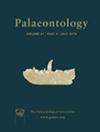Eocene palaeoenvironments and palaeoceanography of areas adjacent to the Drake Passage: insights from dinoflagellate cyst analysis
IF 2.3
2区 地球科学
Q1 PALEONTOLOGY
引用次数: 3
Abstract
A proper understanding of the palaeoceanographic evolution of the Drake Passage during the Palaeogene is hampered by the lack of precise tools to date and correlate the sedimentary units of areas adjacent to the region. In this work, considering recently published radiometric U–Pb dates, we revised the age of a previous dinoflagellate zones for the middle to upper Eocene units of the Austral–Magallanes Basin. The quantitative analysis of middle to late Eocene dinoflagellate cyst assemblages from different localities close to the Drake Passage allowed us to reconstruct the palaeoenvironmental conditions and the possible surface ocean currents during this time in the area. Assemblages dated between 41.3 and 38.1 Ma represent relatively warm waters in inner shelf settings, while those ranged between 36 and 35 Ma reflect coastal areas with cool, nutrient‐rich surface waters. The proposed surface ocean circulation pattern, based on dinoflagellate cysts distribution between 41.3 and 38.1 Ma, agrees with the results of a palaeoclimatic numerical model simulation performed with a Drake Passage shallow opening of 100 m depth. At c. 36 Ma, several Antarctic gonyaulacacean taxa tolerant to relatively warmer waters were replaced by some Antarctic peridinacean species better adapted to colder conditions. This change could be linked to a progressive deepening of the Drake Passage that is estimated to have reached 1000 m depth promoting a cooling in the South Atlantic. Such passage depth would have enabled stronger flows from the Pacific to the Atlantic Ocean, which is reflected by the increase of cosmopolitan species.德雷克海峡附近地区始新世古环境与古海洋学:鞭毛藻囊分析的启示
由于缺乏精确的工具来确定和关联该地区附近地区的沉积单元,对德雷克海峡在古近纪的古海洋演化的正确理解受到了阻碍。在这项工作中,考虑到最近公布的放射性U–Pb日期,我们修改了澳大利亚-麦哲伦盆地始新世中上部单元先前甲藻带的年龄。对德雷克海峡附近不同地区始新世中晚期甲藻囊肿组合的定量分析使我们能够重建该地区在此期间的古环境条件和可能的地表洋流。41.3年至38.1年的组装 Ma代表了内陆架环境中相对温暖的水域,而温度在36到35之间 马反映了沿海地区凉爽、营养丰富的地表水。根据甲藻囊肿41.3至38.1之间的分布,提出的表层海洋环流模式 马同意德雷克海峡浅口100米的古气候数值模型模拟结果 m深度。在c。 36 马说,一些对相对温暖的水域具有耐受性的南极gonyaulacacean分类群被一些更好地适应寒冷条件的南极peridinacean物种所取代。这一变化可能与德雷克海峡的逐渐加深有关,据估计,德雷克海峡已达到1000 m的深度促进了南大西洋的降温。这样的通道深度将使从太平洋到大西洋的水流更加强劲,这反映在世界性物种的增加上。
本文章由计算机程序翻译,如有差异,请以英文原文为准。
求助全文
约1分钟内获得全文
求助全文
来源期刊

Palaeontology
地学-古生物学
CiteScore
5.60
自引率
3.80%
发文量
43
审稿时长
6 months
期刊介绍:
Palaeontology publishes a wide variety of papers on palaeontological topics covering:
palaeozoology
palaeobotany
systematic studies
palaeoecology
micropalaeontology
palaeobiogeography
functional morphology
stratigraphy
taxonomy
taphonomy
palaeoenvironmental reconstruction
palaeoclimate analysis and biomineralization studies.
 求助内容:
求助内容: 应助结果提醒方式:
应助结果提醒方式:


